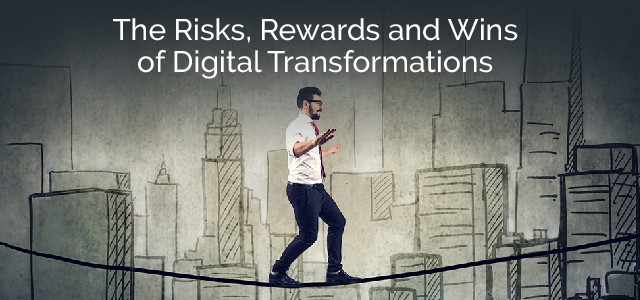The Risks, Rewards and Wins of Digital Transformations
Estimated reading time: 5 minutes
As technology advances, so should your business. Digital transformations offer thorough advancement of technology and a positive effect on your operations. They should be met with clear objectives to enhance the customer experience and user adaptation internally to be successful.
In a recent AdVic “Salesforce Simplified” podcast, Ali Davachi, CEO of Realware, spoke about the risks, rewards and wins of taking on a digital transformation. Here are some highlights from that episode…
From your experience, why do digital transformation projects fail?
“I think across all the different industries that we’re involved in, the most common issue is not defining the outcomes clearly. Not technical outcomes, but the desired business outcomes, the ‘why’ of the project itself. You can pretty much draw a line from each of those failures to the lack of that clear understanding. If you have that outcome clearly defined, and you’re communicating that throughout your organization, then digital transformation or transformation of any kind, frankly, becomes far easier to implement and continue to use on a day-to-day basis.”
Bottom Line:
- Clearly define expected business outcomes.
- Know the “why.”
- Communicate throughout your organization.
“I think a lot of businesses today, particularly after the last year of the pandemic, have had a big struggle meeting customers where they are.”
When do you think that a business should consider a system upgrade or a digital transformation project?
“That’s a great question, because I feel that system upgrade and digital transformation are really not the same thing in many cases. I think you can actually execute a successful digital transformation without a system upgrade, but that all depends on what your outcomes are and what your total goals are to serve your customer base. For example, if you’re trending to a younger, more digitally savvy customer base, then you may need to do that upgrade because you need to meet your customer where they are.
“I think a lot of businesses today, particularly after the last year of the pandemic, have had a big struggle meeting customers where they are. We’ve helped a lot of businesses here in our area to make that transition through using additional digital tools and upgrading systems so that they can present an online presence or mobile presence to that customer and not force the customer into the presence that they want to have.
“Separate the two first. Separate the digital transformation from the system upgrade. And then once you’ve defined what it means to transform your digital presence or to create even a digital presence, then you can start looking at your systems and decide where does that spend make sense, where does that upgrade make sense.”
Bottom Line:
- Cater to the needs of the customer.
- Advance with technology.
- Know the difference between digital transformation and system upgrades and when they make sense.
Could you give four of the most important things that you think companies need to consider so that they make sure that their digital transformation project is a success?
“I think the first would be outcomes.
“Number two, let’s say transparency. Be completely transparent, both internally and externally. Communicate with your customers. Let them know what you’re doing, why you’re doing it. Let the internal folks know what they’re doing, why you’re doing it. Clear communications around all the steps that are going to be required, all the changes that are going to be required. Like you mentioned, change management; it’s really critical that everyone understands as the project starts, that they’re going to have an impact. It shouldn’t be a surprise three months down that some department is now impacted. You should really think through all of those things ahead of time, through your change management process.
“Number three is risk. Really, really focus on risk. What are the areas where even if you have a successful implementation and everything goes well on the technical side, where are the risk factors? Where’s the human risk factors? Training, adoption, convincing people that it’s the right choice to move forward.
“The last one I would say is, start easy. Don’t try to solve the big problems first start with the easy problems, the low hanging fruit, as people say, because you start to build that trust. You’ll get more goodwill when they see positive outcomes from the project, and then you can gain momentum there. And that momentum will serve you when you hit some rough spots. It’ll help you get through those rough spots that you’ll inevitably have. Look for the smaller bits that you can go after that can give some benefit to the clients, give some benefit to your internal teams and then go after the bigger items in your transformation. That’s a really important piece I think, to grow that trust”
Bottom Line:
- Be transparent. Share what and why you are undergoing a digital transformation or system upgrade internally and externally.
- Communicate how the transformation will impact day-to-day operations at work.
- Weigh the risks.
- Start “low” then continue to progress as momentum and trust from the team propels you forward.
If your company is struggling with growth or it takes numerous team members to execute manual processes that could be solved with automation, it’s time to consider a digital transformation…and it doesn’t have to be a difficult process. Let AdVic show you how.
More Digital Transformation Resources:
Digital Transformation 101: Your Questions Answered
Five-Steps to a Successful Digital Transformation


